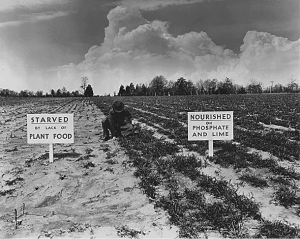Phosphorous is an essential nutrient required by plants. It is responsible for healthy root development and fruit and flower production. As a critical ingredient in fertilizers Phosphorus is used to sustain our ever-growing population. The supply of available phosphorous limits the size of the population possible in an ecosystem. With no substitute, this essential nutrient to plant life and indirectly human sustainability is the gravest natural resource shortage you’ve never heard of.

Tennessee Valley Authority: Results of Fertilizer
Author: Franklin D. Roosevelt Presidential Library and Museum, via Wikimedia Commons
We are all familiar with the term “peak oil” but the notion of “peak phosphorus” has been given little attention. As a non-renewable resource, estimates of global reserves of phosphate suggest that supplies may only last for another 50-130 years. The consequences of limited resource supply, however, begin long before supplies actually run out. They begin once production reaches its peak and for phosphorus, Physicist Patrick Déry estimates that U.S. “peak phosphorus” occurred in 1988 and in 1989 for the world . We are quickly approaching a threshold where world agricultural requirements may begin to outpace available supplies of phosphorus.

A graph of world phosphate rock production vs. year from 1900-2009
Source: U.S. Geological Survey, via Wikimedia Commons
As human population continues to grow and phosphorus declines, greater food production will be a necessary. In order to maintain higher food production more phosphorus will be needed, which will cause drastic spikes in fertilizer and food prices. For example a 2010 Foreign Policy article by James Elser and Stuart White stated that between 2003 and 2008 phosphate fertilizer prices rose approximately 350 percent and in 2008 the resulting food prices sparked riots in more than 40 countries. Although the spike in fertilizer prices was only partially responsible for the higher food prices, the riots illustrate the social upheaval caused by disruptions to the world’s food supply.
Fortunately, serious consequences from a phosphorus crunch are avoidable if concerted efforts are made to implement good practices. These include genetic engineering of crops, erosion control and targeted application of fertilizer. More environmentally friendly solutions include returning to the practice of growing crops near where farm animals are raised, so their manure and urine can replenish phosphate in soil and reducing overconsumption of our current food supply.
The depletion of the supply of phosphorus is a globally threatening issue. If we fail to meet this challenge, humanity is threatened to face widespread famine. This startling outlook for the future of humanity does not, however, need to be our fate. We know the problem, and we know the solution; the only thing left is for governments to implement it.
-Nicole Gehring
